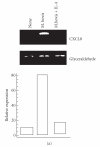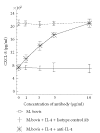Expression and secretion of CXCL-8 and CXCL-10 from mycobacterium bovis BCG-infected human epithelial cells: role of IL-4
- PMID: 16864907
- PMCID: PMC1570386
- DOI: 10.1155/MI/2006/67451
Expression and secretion of CXCL-8 and CXCL-10 from mycobacterium bovis BCG-infected human epithelial cells: role of IL-4
Abstract
CXC chemokine release can be modulated by Th2-derived cytokines. Interleukin(IL)-4 is one of the cytokines that are the hallmark of the Th-2 response, and plays an important role in human tuberculosis. In the current study, we investigated the effect of IL-4 on chemokine production by human epithelial cells infected with Mycobacterium bovis bacillus calmette-guérin (BCG). Gene expression of CXCL-8 and CXCL-10 was determined by the reverse transcription (RT)-polymerase chain reaction method. The levels of immunoreactive CXCL-8 and CXCL-10 were determined by enzyme-linked immunosorbent assay. We found that, although M. bovis BCG induced gene expression of CXCL-8 and CXCL-10 in M. bovis BCG-infected human epithelial cells, CXCL-8 mRNA level was significantly reduced by IL-4, whereas no significant effect of IL-4 was observed on CXCL10 mRNA level. In addition, IL-4 decreased CXCL-8 (in a graded and significant manner) but not CXCL-10 secretion. These results were further confirmed, since a significant reversion was obtained with a neutralizing antibody to human IL-4, whereas an isotype-matched control antibody had no significant effect on CXCL-8 secretion. Furthermore, we found a similar effect of IL-4 on M. bovis BCG-induced CXCL-8 and CXCL-10 secretion by using other human epithelial A549 cell line. Collectively, these data demonstrate that M. bovis BCG-infected human epithelial cells can have an active role in a local inflammatory immune response via the secretion of CXC chemokines which can be selectively regulated by Th2-derived cytokines.
Figures






Similar articles
-
Role of type I interferon in the bacillus Calmette-Guérin-induced expression of CXCL10 from human monocytes.Mediators Inflamm. 2004 Dec;13(5-6):343-8. doi: 10.1080/09629350400014099. Mediators Inflamm. 2004. PMID: 15770050 Free PMC article.
-
Secretion of interleukin-8 by human-derived cell lines infected with Mycobacterium bovis.Mediators Inflamm. 2004 Feb;13(1):45-9. doi: 10.1080/09629350410001664743. Mediators Inflamm. 2004. PMID: 15203565 Free PMC article.
-
Mycobacterium bovis Bacillus Calmette-Guérin (BCG) stimulates IL-10 production via the PI3K/Akt and p38 MAPK pathways in human lung epithelial cells.Cell Immunol. 2008 Jan;251(1):37-42. doi: 10.1016/j.cellimm.2008.03.002. Cell Immunol. 2008. PMID: 18423589
-
The protective and pathogenic roles of CXCL17 in human health and disease: Potential in respiratory medicine.Cytokine Growth Factor Rev. 2020 Jun;53:53-62. doi: 10.1016/j.cytogfr.2020.04.004. Epub 2020 Apr 23. Cytokine Growth Factor Rev. 2020. PMID: 32345516 Free PMC article. Review.
-
The role of CXCL family members in different diseases.Cell Death Discov. 2023 Jul 1;9(1):212. doi: 10.1038/s41420-023-01524-9. Cell Death Discov. 2023. PMID: 37393391 Free PMC article. Review.
Cited by
-
The role of airway epithelial cells in response to mycobacteria infection.Clin Dev Immunol. 2012;2012:791392. doi: 10.1155/2012/791392. Epub 2012 Apr 18. Clin Dev Immunol. 2012. PMID: 22570668 Free PMC article. Review.
-
IP-10 Is a Sensitive Biomarker of Antigen Recognition in Whole-Blood Stimulation Assays Used for the Diagnosis of Mycobacterium bovis Infection in African Buffaloes (Syncerus caffer).Clin Vaccine Immunol. 2015 Aug;22(8):974-8. doi: 10.1128/CVI.00324-15. Epub 2015 Jun 24. Clin Vaccine Immunol. 2015. PMID: 26108287 Free PMC article.
-
Lung epithelial cells interact with immune cells and bacteria to shape the microenvironment in tuberculosis.Thorax. 2022 Apr;77(4):408-416. doi: 10.1136/thoraxjnl-2021-217997. Epub 2022 Jan 11. Thorax. 2022. PMID: 35017314 Free PMC article. Review.
References
-
- Flynn JL, Chan J. Immunology of tuberculosis. Annual Review of Immunology. 2001;19:93–129. - PubMed
-
- Algood HM, Chan J, Flynn JL. Chemokines and tuberculosis. Cytokine & Growth Factor Reviews. 2003;14(6):467–477. - PubMed
-
- Zlotnik A, Yoshie O. Chemokines: a new classification system and their role in immunity. Immunity. 2000;12(2):121–127. - PubMed
-
- Taub DD, Anver M, Oppenheim JJ, Longo DL, Murphy WJ. T lymphocyte recruitment by interleukin-8 (IL-8). IL-8-induced degranulation of neutrophils releases potent chemoattractants for human T lymphocytes both in vitro and in vivo. The Journal of Clinical Investigation. 1996;97(8):1931–1941. - PMC - PubMed
-
- Pace E, Gjomarkaj M, Melis M, et al. Interleukin-8 induces lymphocyte chemotaxis into the pleural space. Role of pleural macrophages. American Journal of Respiratory and Critical Care Medicine. 1999;159(5 pt 1):1592–1599. - PubMed
Publication types
MeSH terms
Substances
LinkOut - more resources
Full Text Sources

